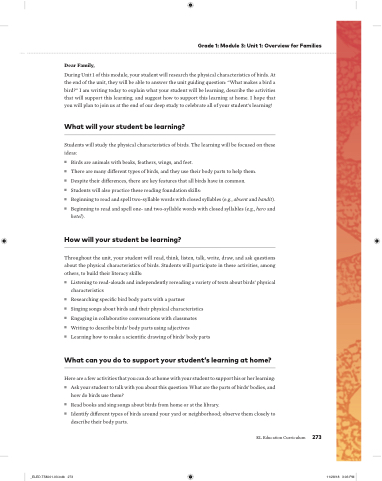Page 327 - CMS Grade 1 Field Test Sampler
P. 327
Grade 1: Module 3: Unit 1: Overview for Families
Dear Family,
During Unit 1 of this module, your student will research the physical characteristics of birds. At the end of the unit, they will be able to answer the unit guiding question: “What makes a bird a bird?” I am writing today to explain what your student will be learning, describe the activities that will support this learning, and suggest how to support this learning at home. I hope that you will plan to join us at the end of our deep study to celebrate all of your student’s learning!
What will your udent be learning?
Students will study the physical characteristics of birds. The learning will be focused on these ideas:
■ Birds are animals with beaks, feathers, wings, and feet.
■ There are many di erent types of birds, and they use their body parts to help them.
■ Despite their di erences, there are key features that all birds have in common.
■ Students will also practice these reading foundation skills:
■ Beginning to read and spell two-syllable words with closed syllables (e.g., absent and bandit).
■ Beginning to read and spell one- and two-syllable words with closed syllables (e.g., hero and hotel).
How will your udent be learning?
Throughout the unit, your student will read, think, listen, talk, write, draw, and ask questions about the physical characteristics of birds. Students will participate in these activities, among others, to build their literacy skills:
■ Listening to read-alouds and independently rereading a variety of texts about birds’ physical characteristics
■ Researching speci c bird body parts with a partner
■ Singing songs about birds and their physical characteristics
■ Engaging in collaborative conversations with classmates
■ Writing to describe birds’ body parts using adjectives
■ Learning how to make a scienti c drawing of birds’ body parts
What can you do to support your udent’s learning at home?
Here are a few activities that you can do at home with your student to support his or her learning:
■ Ask your student to talk with you about this question: What are the parts of birds’ bodies, and how do birds use them?
■ Read books and sing songs about birds from home or at the library.
■ Identify di erent types of birds around your yard or neighborhood; observe them closely to
describe their body parts.
EL Education Curriculum 273
_ELED.TSM.01.03.indb 273
11/28/18
3:03 PM


